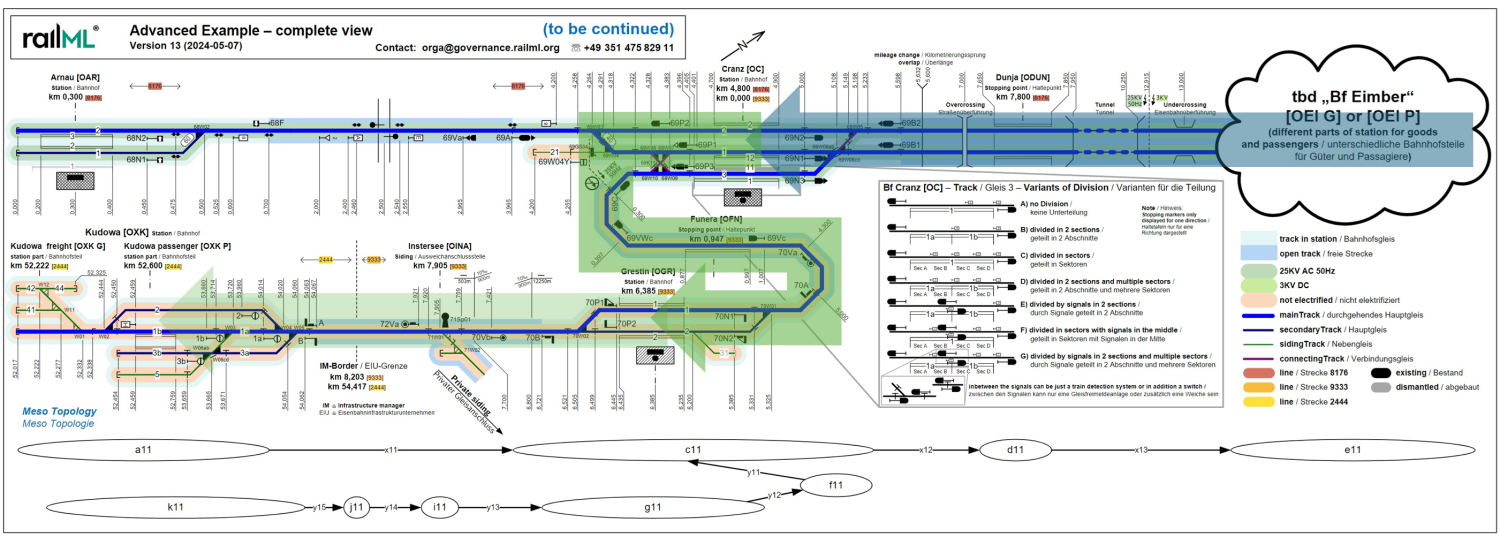|
|
| Line 10: |
Line 10: |
| {{importComment}} | | {{importComment}} |
| =={{examples}}== | | =={{examples}}== |
| | |
| | Below itinerary "it-11" combines base itineraries "bi-1" and "bi-7". This allows to go Arnau to Kudowa. |
| | |
| | <range> children of "it-11" should be interpreted as follows: |
| | |
| | Train arrives at "bp-2" and departs from "" |
| | |
| | The following conditions are true: |
| | * <range> children of "it-11" so to say "intersect": both "bp-2" and "bp-22" refer to Cranz |
| | |
| | operational points source code |
| | |
| | tracks source code |
| | |
| | base itineraries source code |
| | |
| | itinerary source code |
|
| |
|
| [[File:2024-07-29_railML_itineary.png|1500px]] | | [[File:2024-07-29_railML_itineary.png|1500px]] |
Revision as of 15:50, 29 July 2024
Introduction
Documentation
Syntax
Autoexport from the XML-Schema for element TT:itinerary of railML ® version 3.2 |
| Documentation
|
An Itinerary is created based upon one or several base itineraries. The base itineraries can be cut into parts and recombined for that. Additionally they can be transposed in time.
|
| Subschema
|
timetable
|
| Parents*
|
itineraries
|
| Children
|
range (1..*)
|
Attributes:
- id: unique identifier (obligatory;
xs:string; patterns: (urn:uuid:)?[0-9a-fA-F]{8}-[0-9a-fA-F]{4}-[0-9a-fA-F]{4}-[0-9a-fA-F]{4}-[0-9a-fA-F]{12}|{[0-9a-fA-F]{8}-[0-9a-fA-F]{4}-[0-9a-fA-F]{4}-[0-9a-fA-F]{4}-[0-9a-fA-F]{12}}); compare: Dev:Identities
|
*Notice:
Elements may have different parent elements. As a consequence they may be used in different contexts.
Please, consider this as well as a user of this wiki as when developing this documentation further.
Aspects that are only relevant with respect to one of several parents should be explained exclusively in the documentation of the respective parent element.
|
This element does not appear in railML® 3.1 within the TT subschema. It is available only in railML® 3.2. Do not hesitate to contact railML.org for further questions.
Changes 3.1→3.2
Introduced with version 3.2.
Semantics
Best Practice / Examples
Below itinerary "it-11" combines base itineraries "bi-1" and "bi-7". This allows to go Arnau to Kudowa.
<range> children of "it-11" should be interpreted as follows:
Train arrives at "bp-2" and departs from ""
The following conditions are true:
- <range> children of "it-11" so to say "intersect": both "bp-2" and "bp-22" refer to Cranz
operational points source code
tracks source code
base itineraries source code
itinerary source code

Additional Information
Notes
Open Issues
